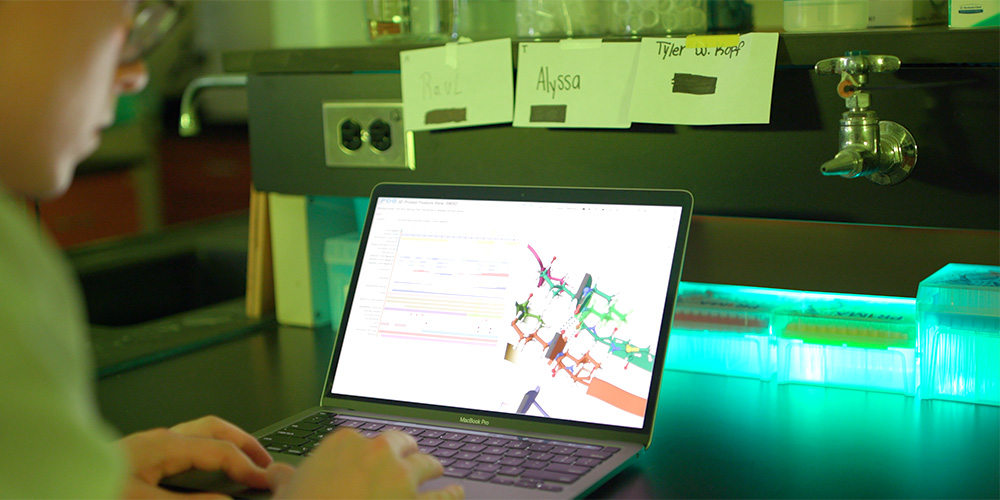
Can the Human Body Heal Itself?
By Laura Phelps
Every year, millions of people around the world lose precious memories, basic motor functions and the ability to talk, think or reason because of debilitating neurological disorders or injuries.
Parkinson’s disease, Alzheimer’s and other similar disorders cost the global healthcare system trillions of dollars every year. Without question, though, the emotional toll is far greater. Friends and family watch these diseases slowly take their loved ones as they wait and hope for a scientific breakthrough that leads to a cure.
In 2023, Jacksonville University students worked toward these kinds of breakthroughs in emerging areas of biomedical research, looking for ways to help the human body heal itself.
“With neurodegenerative diseases, you have a genetic mutation that causes proteins to clump in the brain, which causes chronic inflammation,” said Priscilla Waldera, who graduated that year with her bachelor's degree in biology with a minor in chemistry. “I’ve always wondered if you can reduce the inflammation and overcome the symptoms of the mutation as though it has no effect. Is there a way to prolong the life of the patient and treat the symptoms without an invasive treatment?”
Waldera was selected for a competitive undergraduate biomedical research internship at Mayo Clinic in 2023. She spent several months in laboratories researching human leukocyte antigens genes, which play a significant role in disease and immune defense.
The genes Waldera studied serve as messengers that tell the human body to respond in a certain way, such as attacking foreign organisms in the body or reducing inflammation. This area of research, which explores stem cell therapies, could one day lead to innovative new treatments that slow neurological diseases and prolong patient lives.
She described it this way: “Imagine [stem cells] are cargo trucks that carry lots of little envelopes with messages, and these envelopes are called extracellular vesicles (EVs). With the Mayo Clinic research, we’re getting these envelopes that the stem cells produce and trying to deliver those to the patients. Instead of having to deliver the truck with the cargo in it, why not just get the cargo itself and deliver it?”
Some patients respond negatively to stem cell therapy because their immune systems attacks the foreign cells. Researchers have been exploring whether bypassing the stem cell (the cargo truck) and directly delivering the EVs (the messages) may successfully trigger certain immune responses and offer a less invasive treatment option.
Waldera was also interested in research in which stimulation in certain areas of the brain triggered salamanders to regrow a limb. Her hope is to one day join a research team studying this kind of neuroregeneration.
Similarly, Tyler Kopf, who earned a bachelor’s degree in chemistry with a specialization in biochemistry in 2024, studied neuroregeneration in the spinal cord. Kopf was selected for the National Science Foundation’s Research Experiences for Undergraduates program at the University of Notre Dame, where he joined a team of researchers studying dorsal entry zones in the spinal cord and proteins that help signal nerve cell growth.
“Nerve cells search for partners. When one of them gets cut, it wants to find a partner, and it keeps building structures as it searches for a new partner. They’ll extend their structure, and they’ll retract it, extend it and retract, and if they don’t find something, then eventually they give up,” explained Kopf. Once the nerve cells give up, they die, and that leads to loss of function.
“You need to be able to support the cell enough that it can find its way into the dorsal root entry zone,” he said. To do that, researchers focus on a specific protein that helps nerve cells bind to receptors and dictates the stages of cell development. Learning how to manipulate this protein could be the key to nerve cell regeneration, researchers believe.
“When those nerves can go back into that zone, now you have a new hope of integrating that nerve cell back into the whole body, into the whole system and possibly regaining function,” Kopf said.
Kopf, now a graduate student studying biochemistry and molecular biology at the University of Florida College of Medicine, is hopeful that one day this research will not only help paralyzed individuals walk again but will also reverse the effects of neurodegenerative diseases by helping the brain regenerate lost nerve cells.
